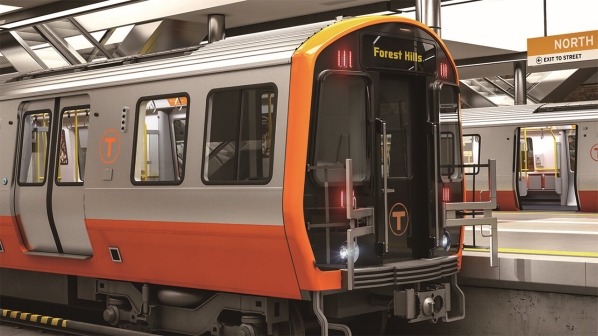The CIP, a rolling five-year plan that is updated annually, brings a $US 1bn increase over the most recent five-year CIP. Officials said the CIP includes all MassDOT rail and transit projects, including those of MBTA and regional transit authorities.
The CIP includes investments ranging in scale and in purpose - from small-scale maintenance projects to large-scale multimodal modernisation projects. It also encompasses long-term investments and funding obligations to maintain, modernise and expand the transport system.
Approximately 45% of the $US 18.3bn in total investments identified for the next five years will focus on the reliability and resiliency of the core transport system.
Another 28% of the funding is allocated to modernising the system in order to accommodate anticipated growth and respond to increased accessibility and safety requirements that may not have existed when the assets were originally built.
Highlights of the CIP include:
$US 1.58bn for Red Line/Orange Line improvements: This programme includes all investments related to replacing and expanding the Red Line and Orange Line fleets and upgrading the facilities and infrastructure needed to support the new trains. When fully implemented, these investments are expected to allow three-minute headways on the Red Line and four-and-a-half minute headways on the Orange Line. The total cost of these improvements is $US 2.8bn. Investments include:
- $US 753.7m for 252 new Red and 152 new Orange Line vehicles, a complete replacement of existing fleets on both lines
- $US 591.5m for maintenance facilities and infrastructure to accommodate the new trains, and
- $US 253m to re-signal the network with a modern digital system, which will increase reliability and reduce headway.
$US 875m for additional capital investments in the Red Line, including:
- $US 114.9m for rehabilitating Longfellow Approach, including $US 109.5m of new funding in this year’s CIP
- $US 118m in new funding for the Mattapan High Speed Line Transformation, for initial investments for bridges, stations, track, and other infrastructure to modernise the Mattapan Line, and
- $US 640.6m for other improvements to the Red Line, including bridges, track, signals, stations, accessibility improvements, and wayfinding.
$US 1.36bn for the Green Line Extension Project. This project consists of constructing a 7.5km light rail line, which will extend the current Green Line from a relocated Lechmere Station in East Cambridge, to a terminus at College Avenue in Medford with a branch to Union Square in Somerville. The $US 2.3bn project is being funded with federal and state support of $US 1.99bn, along with pledged contributions for the project totalling approximately $US 296m from the cities of Cambridge and Somerville ($US 75m), the Boston MPO ($US 157m) and MassDOT ($US 64.3m through special obligation bonds). Investments in this CIP include:
- $US 1.1bn for tracks, bridges, signals, stations, and other infrastructure work
- $US 86.7m for 24 accessible vehicles to address new demand from the Green Line Extension, and
- $US 29.4m for mitigation including buses.
$US 1bn for the South Coast Rail Project, a commuter rail link between Fall River/New Bedford and Boston, which is intended to enhance regional mobility and support smart growth planning and development strategies in Southeastern Massachusetts. The 2020 - 2024 CIP includes full funding for Phase 1 construction and operation via the Middleborough route. The scope of work includes:
- 59.7km of track and infrastructure upgrades
- six new commuter rail stations
- two new overnight layover facilities, and
- reconstruction of 28 level crossings, 14 bridges, and 63 culverts
$US 913m for the Green Line Transformation, a portfolio of more than 90 projects aimed at holistically revitalising the Green Line. Investments include:
- $US 296m in track and signal improvements, including significant efforts on the D branch and within the central tunnel that will reduce delays and eliminate speed restrictions
- $US 214m to begin procuring the Type 10 Green Line LRVs, which will be fully accessible and larger than the existing fleet to address rider demand. This CIP includes the initial down payment for a complete fleet replacement estimated at over $US 1bn
- $US 83m for the Green Line Train Protection System, and
- $US 55m for rehabilitation of the Lechmere Viaduct in order to accommodate the heavier Type 10 vehicles.
$US 538.6m for the Commuter Rail Safety and Resiliency Program. This includes investments to improve the safety and resiliency of the commuter rail system, including the implementation of Positive Train Control (PTC) and Automatic Train Control (ATC). The total cost of this programme including investments in past years is $US 930.8m. The investments in this CIP include:
- $US 171.9m to complete implementation of PTC across all commuter rail lines, and
- $US 313.8m to upgrade signal systems to ATC on the North Side Commuter Rail Lines.
More than $US 2.3 billion in funding for municipalities. The CIP includes several different programmes that provide state and federal funds either through direct grants or reimbursements to cities and towns, and or by leveraging private investment in support of economic development. This includes:
- $US 1bn for the Chapter 90 programme
- $US 1.2bn in federal funds programed for municipal projects through the MPO process
- $US 56.2m for the municipal small bridge programme
- $US 50.2m for the mobility assistance programme
- $US 40.5m for the complete streets funding programme, and
- $US 15m for the industrial rail access programme.

